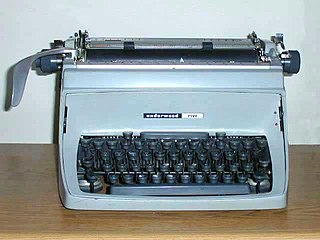 W
WA typewriter is a mechanical or electromechanical machine for typing characters. Typically, a typewriter has an array of keys, and each one causes a different single character to be produced on paper by striking an inked ribbon selectively against the paper with a type element. At the end of the nineteenth century, the term 'typewriter' was also applied to a person who used such a device.
 W
WThe Blickensderfer Typewriter was invented by George Canfield Blickensderfer (1850–1917) and patented on August 4, 1891. Blickensderfer was the nephew of the inventor of the stenotype John Celivergos Zachos. Two models were initially unveiled to the public at the 1893 World's Columbian Exposition in Chicago, the Model 1 and the Model 5. His machines were originally intended to compete with larger Remington, Hammond and Yost typewriters, and were the first truly portable, full-keyboard typewriters. The design also enabled the typist to see the typed work at a time when most typewriters were understrike machines that concealed the writing. When Blickensderfer unveiled his small Model 5 at the 1893 World's Fair, a stripped-down version of his larger more complex Model 1 machine, these revolutionary features attracted huge crowds and a full order book – many of them from Britain, Germany and France, whose business machine markets were more highly developed than the United States.
 W
WA Chinese typewriter is a typewriter that can type Chinese script. Early European typewriters began appearing in the early 19th century. However, as the Chinese language uses a logographic writing system, fitting thousands of Chinese characters on the machine needed much more complex engineering than typewriters using a simple Latin alphabet, or other non-logographic scripts. An ordinary Chinese printing office uses 6,000 Chinese characters. Chinese typewriters, and similar Japanese typewriters invented by Kyota Sugimoto, which use kanji adopted from the Chinese writing system, started to appear only in the early 20th century. There have been at least five dozen versions of Chinese typewriters, ranging from sizable mechanical models to sophisticated electric word processors.
 W
WCorrection paper, or correction film, its plastic based equivalent, is a tab of plastic with one side coated with white correction material. It is used to correct typing errors made when using a typewriter. When inserted between the paper and the ribbon, the impression of the typebar presses the shape of the character into the film, which prints the white correction material onto the paper, hiding the erroneous character and preparing the document for the correct character.
 W
WCorrection tape is an alternative to correction fluid used to correct mistakes during typing, or, in some forms, handwriting. One side of the tape, which is placed against the area to cover, is coated in a white, opaque masking material. Pressure applied to the other side of the tape transfers this material to the paper. Unlike correction fluid, the covered area can be written on it immediately after applying. As it is solid, correction tape is not subject to misuse as an inhalant, unlike most correction fluids.
 W
WLucien Stephen Crandall was an American inventor of typewriters, adding machines and electrical devices. Crandall gave his name to several typewriters, and he was also involved in the development of various machines, such as the project to produce the Hammond design at the Remington factory, or later the International typewriter.
 W
WEmmet Densmore was an American businessman, physician and natural hygiene advocate who promoted an early version of the Paleolithic diet.
 W
WJames Densmore was an American businessman, inventor and vegetarian. He was a business associate of Christopher Sholes, who along with Carlos Glidden and Samuel W. Soule helped contribute to inventing one of the first practical typewriters at a machine shop located in Milwaukee, Wisconsin.
 W
WDot matrix printing, sometimes called impact matrix printing, is a computer printing process in which ink is applied to a surface using a relatively low-resolution dot matrix for layout. Dot matrix printers typically use a print head that moves back and forth or in an up-and-down motion on the page and prints by impact, striking an ink-soaked cloth ribbon against the paper, much like the print mechanism on a typewriter or line printer. However, a dot matrix printer is able to print arbitrary patterns and not just specific characters.
 W
WE. Remington and Sons (1816–1896) was a manufacturer of firearms and typewriters. Founded in 1816 by Eliphalet Remington in Ilion, New York, on March 1, 1873, it became known for manufacturing the first commercial typewriter.
 W
WThe Friden Flexowriter was a teleprinter, a heavy-duty electric typewriter capable of being driven not only by a human typing, but also automatically by several methods, including direct attachment to a computer and by use of paper tape.
 W
WCarlos Glidden, along with Christopher Sholes, Frank Haven Hall, and Samuel W. Soule, invented the first practical typewriter at a machine shop in Milwaukee, Wisconsin. He kept on improving the typewriter until he died.
 W
WHalda Watch Company is a Swedish manufacturer of high-end watches. It was founded in 1887 by Henning Hammarlund in Svängsta.
 W
WFrank Haven Hall was an American inventor and essayist who is credited with inventing the Hall braille writer and the stereographer machine. He also invented the first successful mechanical point writer and developed major functions of modern day typography with kerning and tracking.
 W
WThe Hammond Typewriter was invented by James Bartlett Hammond and first manufactured in 1881. The typeface used by the typewriter was also available as foundry type from the Inland Type Foundry. John Jonathon Pratt sold his 1882 patent rights to the company for the manufacture of the typewriter.
 W
WThe Hansen Writing Ball is an early typewriter. It was invented in 1865 and patented and put into production in 1870, and was the first commercially produced typewriter.
 W
WThe Hermes 3000 was a lightweight, segment-shifted portable typewriter manufactured by Paillard-Bolex. "Bulbous" and "angular" in shape, it came with a fitted, hard-shell removable cover. The machines were built in Yverdon, Switzerland, by Paillard S.A.
 W
WThe Imperial Typewriter Company was a British manufacturer of typewriters based in Leicester, England.
 W
WThe first practical Japanese typewriter was invented by Kyota Sugimoto in 1915. Out of the thousands of kanji characters, Kyota's original typewriter used 2,400 of them. He obtained the patent rights to the typewriter that he invented in 1929. Sugimoto's typewriter met its competition when the Oriental Typewriter was invented by Shimada Minokichi. The Otani Japanese Typewriter Company and Toshiba also released their own typewriters later.
 W
WRasmus Malling-Hansen was a Danish inventor, minister and principal at the Royal Institute for the Deaf.
 W
WDot matrix printing, sometimes called impact matrix printing, is a computer printing process in which ink is applied to a surface using a relatively low-resolution dot matrix for layout. Dot matrix printers typically use a print head that moves back and forth or in an up-and-down motion on the page and prints by impact, striking an ink-soaked cloth ribbon against the paper, much like the print mechanism on a typewriter or line printer. However, a dot matrix printer is able to print arbitrary patterns and not just specific characters.
 W
WJohn Jonathon Pratt was an American journalist and newspaper owner. He was the inventor of the first working typewriters sold to the public. He was born in South Carolina and lived in Alabama, making him a Confederate, which put him at a disadvantage initially in obtaining US patents. He temporarily lived in England, where he developed his typewriter invention and received British patent rights. He sold some of his typewriters in England as early as 1867, which were the first typewriters bought by the public.
 W
WThe Royal Futura is a portable, manual typewriter that was produced and sold from 1958 to 1962, by the Royal Typewriter Company division of Royal McBee Corporation. In appearance, features, and pricing, the introduction of the Futura marked a new direction in the production of Royal portable typewriters. Sales were supported by an aggressive print advertising campaign directed at students, and the Futura itself was heavily discounted towards the end of its run. The radical new design eventually found its way onto other Royal models throughout the early and mid-1960s, and the name "Futura" would appear on another model later in decade.
 W
WThe Royal Quiet Deluxe was a portable typewriter, made by the Royal Typewriter Company, from 1939 until 1959. The first-generation Quiet Deluxe was the first Royal to feature Magic Margin. The first generation of Royal Quiet Deluxe was manufactured from 1939 until 1948, with a gap in production due to World War II. It was the typewriter of choice for Ernest Hemingway.
 W
WClarence Walker Seamans was an American typewriter manufacturer and executive of several organizations involved in the production and sale of the Remington typewriter, including the Union Typewriter Company and the Remington Typewriter Company.
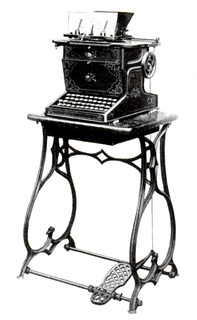 W
WThe Sholes and Glidden typewriter was the first commercially successful typewriter. Principally designed by the American inventor Christopher Latham Sholes, it was developed with the assistance of fellow printer Samuel W. Soule and amateur mechanic Carlos S. Glidden. Work began in 1867, but Soule left the enterprise shortly thereafter, replaced by James Densmore, who provided financial backing and the driving force behind the machine's continued development. After several short-lived attempts to manufacture the device, the machine was acquired by E. Remington and Sons in early 1873. An arms manufacturer seeking to diversify, Remington further refined the typewriter before finally placing it on the market on July 1, 1874.
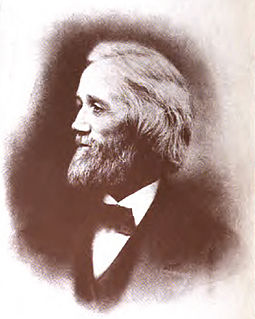 W
WChristopher Latham Sholes was an American inventor who invented the QWERTY keyboard, and, along with Samuel W. Soule, Carlos Glidden and John Pratt, has been contended to be one of the inventors of the first typewriter in the United States. He was also a newspaper publisher and Wisconsin politician. In his time, Sholes went by the names C. Latham Sholes, Latham Sholes, or C. L. Sholes, but never "Christopher Sholes" or "Christopher L. Sholes".
 W
WA steno machine, stenotype machine, shorthand machine, or steno writer is a specialized chorded keyboard or typewriter used by stenographers for shorthand use. In order to pass the United States Registered Professional Reporter test, a trained court reporter or closed captioner must write speeds of approximately 180, 200, and 225 words per minute (wpm) at very high accuracy in the categories of literary, jury charge, and testimony, respectively. Some stenographers can reach 300 words per minute. The website of the California Official Court Reporters Association (COCRA) gives the official record for American English as 375 wpm.
 W
WSwissa was a popular typewriter brand of the post-war era. The Swissa was made by the company Birchmeier's Söhne in Murgenthal (Aargau) and was based on the technical developments of the Patria typewriters. The Swissa Typewriters received much attention due to their product design.
 W
WA teleprinter is an electromechanical device that can be used to send and receive typed messages through various communications channels, in both point-to-point and point-to-multipoint configurations. Initially they were used in telegraphy, which developed in the late 1830s and 1840s as the first use of electrical engineering, though teleprinters were not used for telegraphy until 1887 at the earliest. The machines were adapted to provide a user interface to early mainframe computers and minicomputers, sending typed data to the computer and printing the response. Some models could also be used to create punched tape for data storage and to read back such tape for local printing or transmission.
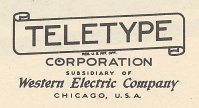 W
WThe Teletype Corporation, a part of American Telephone and Telegraph Company's Western Electric manufacturing arm since 1930, came into being in 1928 when the Morkrum-Kleinschmidt Company changed its name to the name of its trademark equipment. Teletype Corporation, of Skokie, Illinois, was responsible for the research, development and manufacture of data and record communications equipment, but it is primarily remembered for the manufacture of electromechanical teleprinters.
 W
WDot matrix printing, sometimes called impact matrix printing, is a computer printing process in which ink is applied to a surface using a relatively low-resolution dot matrix for layout. Dot matrix printers typically use a print head that moves back and forth or in an up-and-down motion on the page and prints by impact, striking an ink-soaked cloth ribbon against the paper, much like the print mechanism on a typewriter or line printer. However, a dot matrix printer is able to print arbitrary patterns and not just specific characters.
 W
WA typewriter mystery game was a specific type of typewriter art popular in the mid-20th century.
 W
WA typewriter ribbon or ink ribbon is an expendable module serving the function of transferring pigment to paper in various devices for impact printing. Such ribbons are part of standard designs for hand- or motor-driven typewriters, teleprinters, stenotype machines, computer-driven printers and many mechanical calculators.
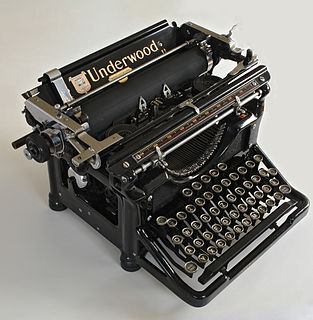 W
W"The Typewriter" is a short composition of light music by American composer Leroy Anderson, which features an actual typewriter as a percussion instrument.
 W
WThe typographer was an early typewriter. It was a mechanical innovation created by William Austin Burt. The mechanism was operated by hand to provide a printed ink impression on paper. Burt was a government surveyor and needed to get official correspondence done quickly. He observed office workers overwhelmed with laborious tasks of handwriting lengthy official documents that took a long time. Burt had a mechanical background so was inspired to make a machine that would speed up secretarial work. A friend of his in the newspaper business furnished typeface letters from a printing press for his experimental mechanism.
 W
WThe Underwood Typewriter Company was a manufacturer of typewriters headquartered in New York City, New York with manufacturing facilities in Hartford, Connecticut. Underwood produced what is considered the first widely successful, modern typewriter. By 1939, Underwood had produced five million machines.